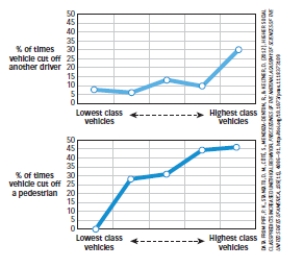Use the following to answer questions
Scenario I
Scenario I is based on and presents data from the following study (reproduced from p.25 of the textbook) :
Piff,P.K. ,Stancato,D.M. ,Côté,S. ,Mendoza-Denton,R. ,& Keltner,D.(2012) .Higher social class predicts increased unethical behavior.PNAS Proceedings of the National Academy of Sciences of the United States of America,109(11) ,4086-4091.doi:10.1073/pnas.1118373109
Piff and colleagues (2012) used naturalistic observation techniques to determine if wealthy people behaved more or less ethically than people who were not wealthy.In one study,observers stood at a busy intersection and recorded the make,model,and year of each approaching car.They also noted if the car cut off other cars or pedestrians at this intersection.
Major findings of Piff et al.(2012) are presented in Figure 1.1.This figure shows the percentage of times vehicles cut off another driver (top panel) or pedestrians (lower panel) as a function of the social status of the vehicles (with more expensive cars ranked higher in social status) .
Figure 1.1 
-(Scenario I) Based on the results shown in Figure 1.1,it is NOT known if:
Definitions:
Reconstructive
Pertaining to the process of rebuilding or forming an approximation of past events or experiences, often used in the context of memory.
Sir Frederic Bartlett
A British psychologist and the first professor of experimental psychology at the University of Cambridge, known for his work on memory and cognitive psychology.
Wax Tablet
An ancient writing surface made of wood covered with a layer of wax, used for writing with a stylus.
Personal Identity
An individual's sense of self, shaped by personal choices, experiences, and social interactions.
Q2: After suffering a stroke,Lisa was able to
Q3: Since Shahida had been employed with Minsk
Q24: When it comes to reporting data truthfully,scientists
Q37: The dependent variable is manipulated by the
Q44: Kerrie wants to understand how perceptions,beliefs,and memories
Q62: Diana wants to see if heat causes
Q72: Hermann Ebbinghaus is BEST known for research
Q91: Which technique helps REDUCE bias due to
Q112: A synchronous pattern of variation between two
Q214: As a feature of ethical research,the term